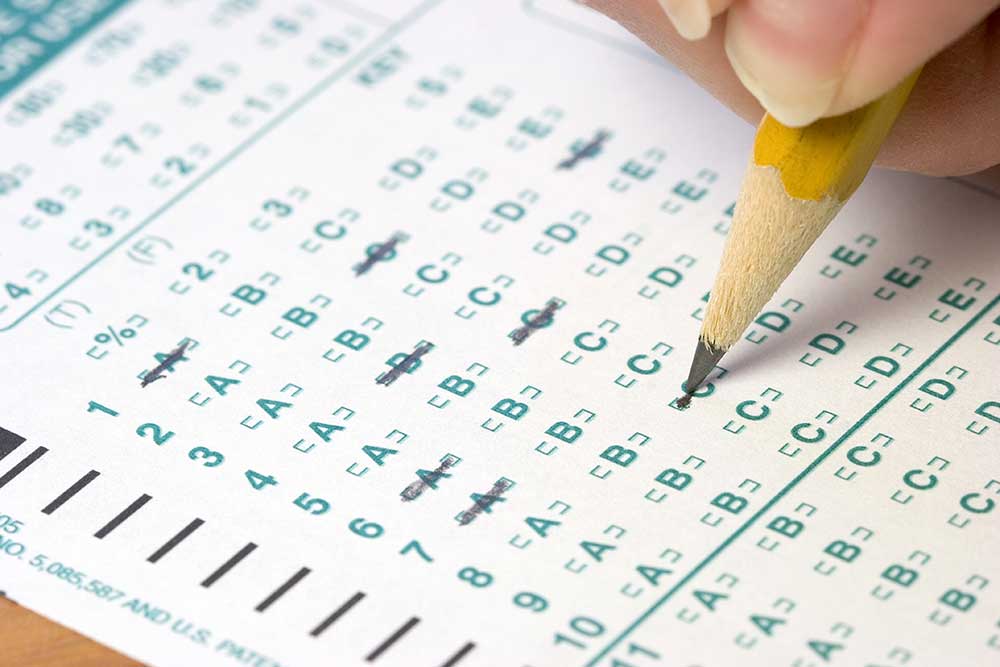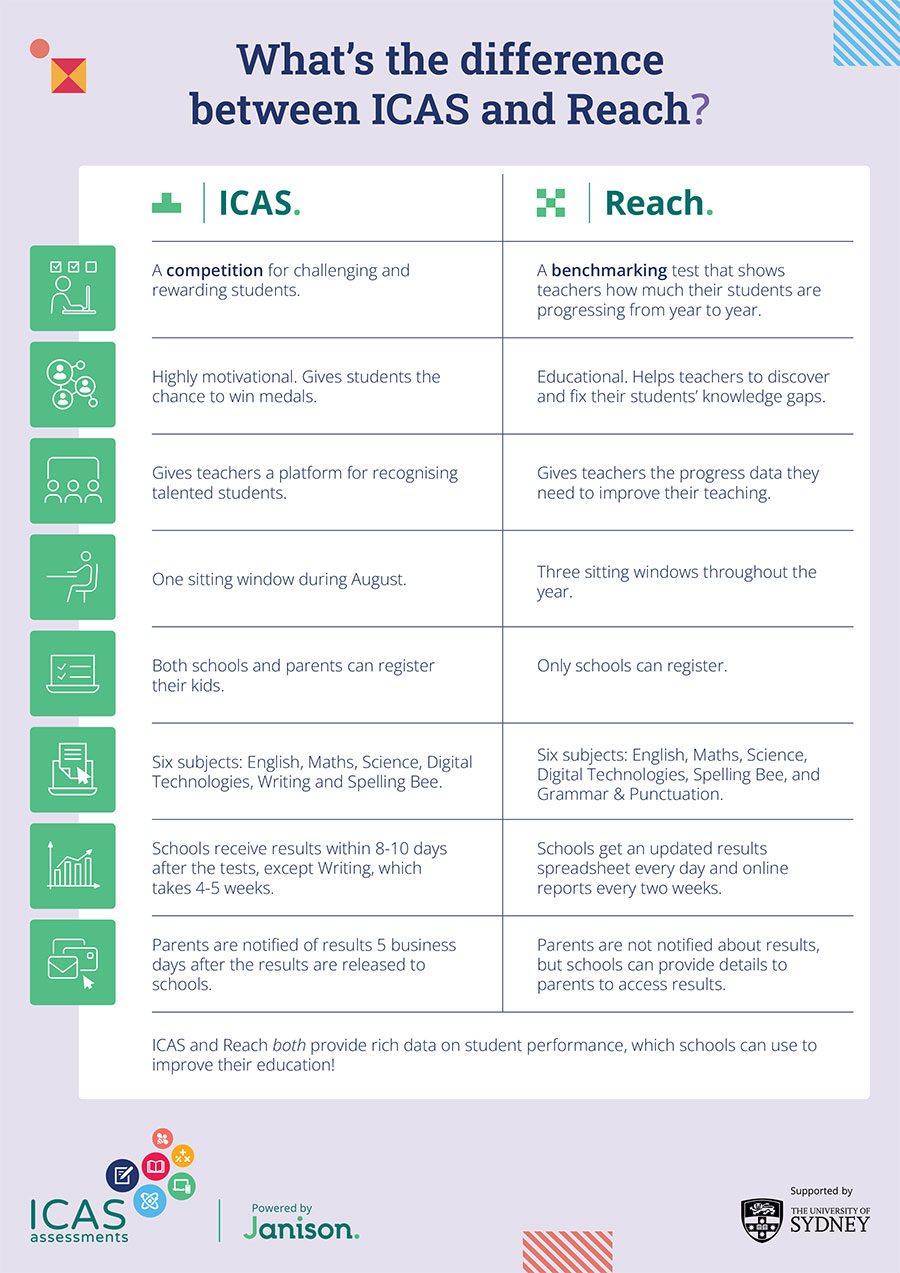What’s the difference between ICAS and Reach?

You likely know ICAS as the academic competition that your child sits at school, giving them a chance to show their talents with tough questions. But you might be wondering about the other assessment that we talk about from time-to-time: Reach.
There are big differences between the two, and in this article, we explore them in detail. If you’d like a summary, you can also find an infographic at the bottom of this blog, as well as the video below.
1. ICAS is a competition, Reach is a benchmarking test
One of the main purposes of ICAS is to challenge students with demanding questions that test their higher-order thinking skills. They get to show their academic mettle and are recognised for their achievements.
Reach, on the other hand, is a benchmarking test that is designed to track student progress from year to year. It’s for teachers to understand, in detail, how their students are progressing through their education compared against benchmarks, and what changes they might need to improve it.
However, even though ICAS is first and foremost an academic competition, teachers still receive in-depth comparative results data for each student, which they can use alongside the Reach data (and other assessments) to build a clearer picture of their skills. Parents receive a version of this data too, for the same reasons. They can use it to get an idea of their child’s strengths and weaknesses, and how they might be able to help.
2. ICAS is for schools and parents, Reach is just for schools
ICAS can be purchased by both schools and parents, whose children then sit the assessments at their school or an ICAS testing centre.
Reach is just for schools. It’s a benchmarking test designed to give teachers data that helps with their teaching, when they most need it.
3. ICAS is motivational, Reach is educational
 Some students love the ICAS competition and find it highly motivational
Some students love the ICAS competition and find it highly motivational
ICAS is an extra-curricular competition that students find motivational – to the point where they want to sit it again immediately after! It’s a challenging, fun assessment that can make students more engaged at school.
Reach is designed to educate teachers on their students’ academic progress, so that they can see where they are on their learning journey compared with the rest of the class, school or nation. This helps them to make evidence-based decisions on how to move forward with their classes. It’s educational for teachers, rather than motivational for students.
4. ICAS identifies high-achievers, Reach analyses all achievement
ICAS is designed to push the academic limits of students with progressively harder questions. The very highest achievers are awarded medals.
Reach is designed to provide an all-round analysis of student achievement – the lowest to the highest – so that teachers can accurately measure their students’ skills and identify where they are on their learning journeys.
5. ICAS has one sitting window, Reach has three
The ICAS competition has one sitting window each year, taking place during August in countries around the world.
Reach has three sitting windows throughout the year:
- January to March – ideal for benchmarking after school holidays
- April to June – great for report-writing and parent teacher interviews
- October to November – perfect for class allocations for the following year.
If you’d like to view the assessment calendars for your region, you can find them here: Australia, New Zealand, Pacific & International.
6. ICAS has six subjects, Reach has seven
Students who sit ICAS can do so in six subjects: English, Mathematics, Science, Digital Technologies, Writing and Spelling Bee. These reflect many of the subjects taught in curriculums around the world.
Reach has all the same subjects plus one more: Grammar & Punctuation. This was to ensure we cover all parts of the NAPLAN tests, giving teachers complete data on their students’ skills. Incidentally, Reach is the only Australian benchmarking assessment that is this comprehensive.
7. ICAS results take 2-4 weeks, Reach results are released daily
 Due to sheer volume, ICAS takes longer to mark than Reach
Due to sheer volume, ICAS takes longer to mark than Reach
Thousands of students sit ICAS every year, so it takes our team around 2 to 4 weeks to process and release the results to schools. Except for Writing, which takes 4 to 6 weeks due to much longer marking. Check out this blog for more detailed info on our results process.
Teachers receive results for Reach at the start of each day, in an updated spreadsheet (they also have access to a results portal, which is updated every fortnight). This quick turnaround ensures that they can start getting immediate insights into their students’ learning.
8. ICAS and Reach have unique bands
ICAS scores are broken down into five certificate bands: high distinction, distinction, credit, merit and participation. In addition, medal winners must achieve the highest score in their region, which must also be deemed sufficiently meritorious when compared to other regions.
Reach scores are broken down into five achievement bands: outstanding, commendable, good effort, satisfactory and participated.
9. ICAS questions are hidden, Reach questions are not
Because ICAS is a competition with interactive questions, when viewing the results data, we hide the questions themselves to retain the integrity of future competitions. Instead, teachers and parents will see a description of the question. For example, a question on syntax has the description “identify the part of the sentence that is the main clause in a biography,” which tells them what the question was about without revealing the question itself.
Reach questions, on the other hand, are fully disclosed to teachers because they help them to delve into the specifics of their students’ skills. They can also be posed as part of classes – an additional assessment tool for teachers.




